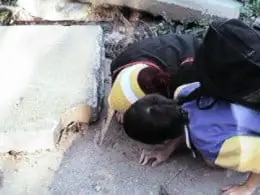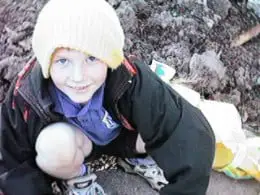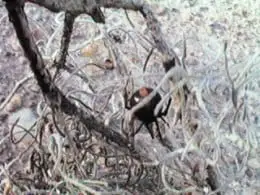PLEASE NOTE THAT AT NO TIME ARE CHILDREN ALLOWED TO HANDLE LIVE SPIDERS AND ARE TAUGHT NOT TO TOUCH ANY SPIDERS, AS ALL CAN BITE. ALL LIVE SPIDERS KEPT IN THE ROOM ARE IN SEALED CONTAINERS AND ARE ONLY FED BY THE TEACHER.
About two weeks after school recommenced in 1998, one of the children in Year 5A, found a tiny Red-back spider in our classroom under a desk. This was not so dramatic a find, as at present in our suburb, we seem to have quite a large number of these small spiders and the children seem to have become quite blasé about them.
Not wanting to kill it outright, we put it in a small bottle, covered the top with clear plastic and left it, forgotten on a shelf.
About a week later, remembering the Red-back in the bottle, we checked it to find that not only amazingly was it still alive, it had also built an untidy nest in the top of the bottle. By a popular decision, we decided that if it had survived that long with no air, perhaps we should put some holes in the top of the plastic so it could breathe. The next weekend we were due to have our room fumigated for spiders to kill off any remaining unwanted guests, and not thinking, we left our Red-back on the shelf under the blackboard. Imagine our surprise again when we arrived at school on Monday to find that the spraying had not affected our spider in the slightest, although it was beginning to look decidedly skinny from lack of food.


The children then commenced a spider food hunt, delivering ants to begin with, which it didn’t seem to like all that much and finally one child found a small grasshopper, which obligingly caught itself in the spider’s web when we put it in the jar.
In a matter of seconds, the Red-back pounced and happily spent the next hour or so, sucking all the juices out of the hapless grasshopper. Finally all that was left was the dried up shell and a very much bigger Red-back. In fact the size of her body increased by several millimetres with that one feed.
This is how we now knew that it was a female, as the males’ bodies remain small while the females’ increase in size as they grow older. The children also discovered that spiders shed their skins as they get bigger as we found some skin that she left behind. It is called “moulting”.
Since then we have moved her to a bigger and better home with twigs and Spanish moss and gravel and she has a lovely home amongst the moss. The children continue to feed her every day or so as we find grasshoppers and small beetles and her body size is now almost 8 millimetres across. When we found her it was only about 2 millimetres. To date, the Red-back has eaten 3 grasshoppers and one small praying mantis.
Here are some of the things we have learnt about our Red-back in the time we have had her:
- Red-backs can go for a long time without air.
- They can also resist insect spray.
- Red-backs’ bodies get bigger when they eat and smaller if they have no food.
- A Red-back makes an untidy web.
- They like to eat grasshoppers and praying mantis.
- They eat their food by sucking the juices from the body, after killing the prey by biting it.
- Red-backs don’t drink water, they get all their fluid from the body of their prey.




Here’s our spider having a feed today. She really enjoyed this grasshopper the kids found for her. You can see the messy web she makes at the top of the sticks. The grasshopper looks all blurry because she has wrapped it up in silk before she eats it.



Now Winter is approaching and the Red-back has been very quiet. We gave her a cockroach last week and she hasn’t touched it. Maybe she doesn’t like cockroaches, but that’s all we could find as grasshoppers seem to be disappearing too, with the start of the cold weather. She hasn’t had anything to eat now for about 2 weeks, we tried a lizard last week, but rescued that from her web when we felt sorry for it.
Well, today we finally found a praying mantis for the Red-back. Boy did she enjoy that! She pounced on it as soon as we put it in the jar, so now she’s fat and happy again. We noticed that her red stripe is not nearly as bright now and more the same colour as the rest of her body.
Now it’s July and Winter is fully upon us. We have just completed 2 weeks holidays and the Red-back has had no food now for nearly 3 weeks. Food is becoming really scarce, all the grasshoppers and praying mantis have gone and even the cockroaches have disappeared. We hold grave concern for the continued existence of our Red-back if we don’t find some food shortly. She is still alive but decidedly on the thin side. We’ll keep looking and hopefully will find some food soon.

Well we’ve been back at school for a week now and still no food to be found. Here’s our Red-back, looking decidely thin on it. Unfortunately, pet shops in Australia don’t usually sell food for spiders as not too many people here keep spiders as pets. So we have decided that if no food is found today, we will release her in the bush at the back of the school tomorrow.
Some good news and bad news – I finally found a pet shop that sells spider food and managed to buy a tub full of crickets for the Red-back, only $5 for a tub full of lovely little jumping insects. I also found out that the local pet shop also sells Bird Eating spiders, so check back next year when I do spiders with a new class and you never know what we’ll have as a class pet!! The pet shop owner gave me a good tip on feeding the crickets to the spider – put them in the fridge for 10 minutes before hand and this slows them right down. Unfortunately, I forgot about them and left them there for an hour so by the time we came to feed the Red-back, they were really slow!!
Finally we managed to get two out and put them in the Red-back’s web, but the web has lost its stickiness now (“And it hasn’t even rained,” as one of the kids said) and the crickets simply walked out of the web when they had revived from their near death experience in the fridge.
Later we put some more in there but the Red-back shows little interest in trying to eat them and they simply walk or limp away, sometimes having lost a leg or two in the process of transferring them via tweezers, to the bottle. I never realised how cute crickets are before and we feel quite sorry for them with their cute little faces and black feelers. There are now about ten wandering around in the spider’s bottle and we’ll see if she shows any interest in eating them overnight.



We also found a small Jumping spider in the sink so we have put that in the Red-back’s bottle to see if it will be either (a) company or (b) food! You can see it in the centre of the bottom of the photo above on the right. So we have now provided plenty of food, we’ll wait and see what happens to it!!
Well, so much for the Jumping spider, poor little thing ended up as a well- wrapped meal for the Red-back. Lucky for the crickets who are all chirping away happily still! At least it seems to have stimulated the Red-back to start rebuilding her web and showing a bit of interest in food, so perhaps they may be next on the menu. The photo below shows the Red-back at the top her of her web, rebuilding it.
Two days later and most of the crickets are still alive. One has been trapped in the web but hasn’t been wrapped up, so has not been eaten yet. The Jumping spider has completely disappeared from the web so she must have enjoyed that meal. The Red-back’s stripe has become nice and red again which hopefully is a sign that she is feeling happier again.
Well, nearly two weeks later, and the Red-back shows little signs of interest in the crickets. One has been caught in her web and she hasn’t even looked at it. Most of the crickets in our container are most unhealthy (read dead!) so we decided to liberate the remainder.




The remaining live crickets quickly scurried off into the nice new garden outside our room, pleased to escape the fate of their less fortunate companions. You can see the uneaten cricket in the web below. We’ll probably let the Red-back go when the weather warms up a bit, it’s blowing a Westerly gale at the moment and extremely cold. So if it’s nice tomorrow, we’ll go and find a nice home in the bush for her.
Today, 30 July, 1998, dawned fine and warmer although still a chilly maximum of 16 degrees Centigrade.
It is almost 6 months now since we found our Red-back and today is the day we say “Good-bye”. After school, we went for a walk up the back of the school grounds to an area outside the fence, which is used for dumping rubbish and is well out of the way of all the kids.

We found a nice piece of concrete and carefully removed the Red-back from its home of 6 months.
We placed her and her web along with some of the Spanish moss and placed it under the edge of a piece of concrete that looked like it might be a good, safe home for her.
Bye Red-back, we hope you find plenty to eat and maybe even a mate to keep you company! It was great to have you visit our room and we have learnt a lot about spiders from having you there.

